The last IJN dreadnoughts: The Nagato and Mutsu (長門型戦艦, Nagato-gata senkan) were the first and at the same time of their kind. Built as dreadnoughts, the fourth Imperial Japanese Navy class, they were also the fastest, largest, and best armed, so far, and represented a new generation illustrated by the “6-6 plan”. They were among the most powerful “super-dreadnoughts” in the world at their entry into service. Marrying excellent protection, a remarkable speed for the time and the most powerful artillery at the moment, eight 16-in (406mm) guns. They could be consider as the Japanese replica to British Queen Elizabeth class. However if they were laid down in August 1917 (Nagato) and June 1918 (Mutsu), they could only be launched in 1919 and 1920 and completed in November 1920 and October 1921, respectively.

wow’s rendition of IJN Nagato in 1945
Quite active during the interwar, notably off China, they were reconstructed in 1933-36 quite extensively: ASW protection was dramatically improved, powerplant modernized, as well as a powerful AA installed and superstructures rebuilt. Perhaps the most remarkable points of their design has been the heptapod mast and ice-breaking bow. Both would have an active part in WW2, but less than other ships, perhaps because they were less “expandable”. UJN Mutsu illustrated herself in the Battle of the Eastern Solomons but was rather inactive after 1943 until one of her ammo magazine blew up and she became a total constructive loss. IJN Nagato was long stationed in Truk but her more notable action was at the Battle of the Philippine Sea in mid-1944 and Leyte Gulf in October, left as an AA platform in Japan (Kure) until July 1945.
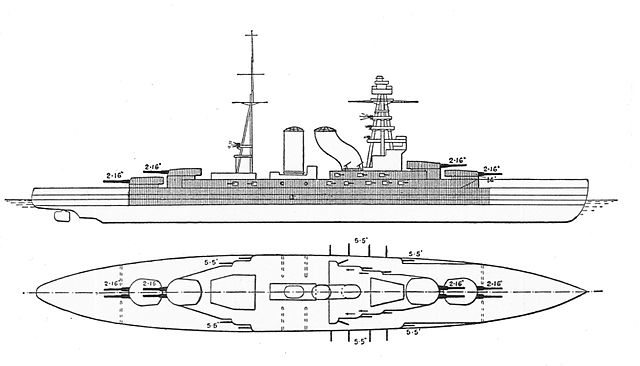
Nagato rendered in Warship today 1936
Genesis and development of the Nagato design
The basis for their construction was the 1907 “8-8 plan” (8 battleships and 8 armoured cruisers). It evolved into eight battleships, eight years old related to the development of dreadnoughts. This led to the construction of the Fuso, Ise, and the four Kongo as “capital ships” but also a third and fourth battleships classes FY 1917 and 1919. In 1915 the Japanese rejected the IJN admiralty plan for four more battleships, and only one was authorized FY 1916: The future Nagato, as well as two battlecruisers (future Atago class). But later that year president Woodrow Wilson announced his plan for 10 more capital ships, the diet authorized three more battleships, including a second FY 1917 (Mutsu) and the future Kaga class.
The Nagato class in 1916 was first called A-102, and the ship was designed by Yuzuru Hiraga, recently entering the Navy Technical Department (NTD).
He chose to adopt the American “all or nothing” armor scheme, consisting in maximizing the protection of some areas while leaving others unprotected. Notably he designed two armoured decks of medium thickness rather than the traditional single one, larger, and an underwater protection able to defeat 200 kgs or 440 ibs of explosive, as found in torpedo warheads of the time, with a deep watertight compartment backed by a torpedo bulkhead connected to the site and deck armor plates, and a deep fuel tank located just behind. A three layered protection, plus internal arrangement with many separate compartments under the waterline.
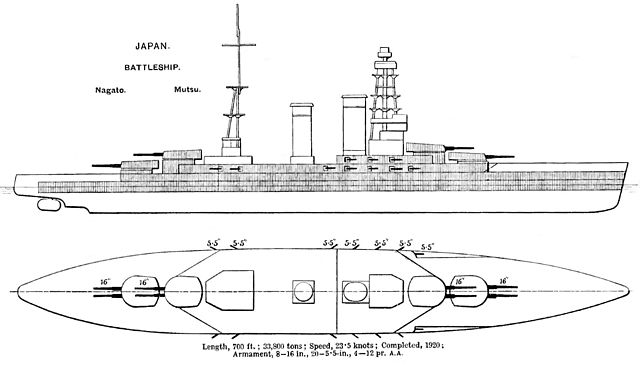
Another remarkable point in the design, was the choice to develop a 410 mm caliber (16.1) instead of 406 (16-in) as planned for future battleships. The idea was more to outclass in range and shell weight the British 381 mm (15 in), before the construction of the Colorado class was announced. At launch, both battleships became the world’s first armed with this artillery, with better range than of the Colorado. Here are the steps of her design:
-A-102 – Nagato preliminary (British design) (1915)
-A-110 – Nagato preliminary (similar to the British design) (1916) 32.500tons 4×2 406mm
-A-112 – Nagato preliminary (after the lessons learned in the Battle of Jutland) (1916)
-A-114 – Nagato class as built (1917)
Construction was approved in 1917 and Their hull was based on that of the Ise, but they had an upper edge in caliber and worn, in default of the volume of fire. This artillery was distributed in a very classical way in two groups of double turrets at the front and rear, in the axis. The pieces, actually displaying a 410 mm caliber, were to form the base of the later 1918 plan, condemned by the Washington Treaty. This artillery was to be supplemented by a secondary armament in barbettes, twenty 5.5 in (140 mm) guns in all, plus eight submarine torpedo tubes and four AA 3-in guns.
However on 12 June 1917, Hiraga announced he would revised the design according to the reports from the Battle of Jutland, nearly one year before, incorporating modifications in armour and integrated the best of boilers technology. The project was renamed A-125 at that stage, and Nagato has been laid down in Kure naval arsenal, but not Mutsu (Yokosuka, nearly one year after). The great change in design was the adoption of better boilers, smaller but more efficient, freeing space to install a fifth turret, which was not on the initial design.
Total numbers of boilers was to be reduced from 21 to 12 and the secondary armament lost four barbette guns, but they were raised in height (on two stages) for better view and less disruption in heavy weather. He also revised IJN Mutsu’s internal armour, making the belt angled outwards to create a slope, artificially increasing thickness in horizontal fire. He also increased the thickness of the lower belt armor and bulkheads, and planned to add anti-torpedo bulges, however these changes would delay the ships’s completion and was rejected by the navy ministry. But these ideas were applied to the next class, Kaga.
Nagato’s hull and general arrangement
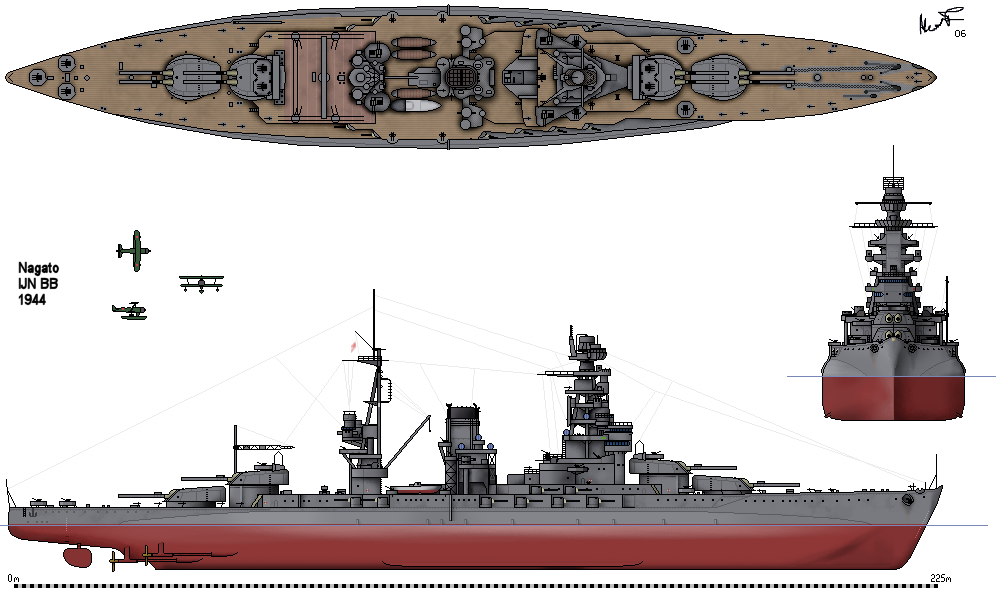
Nagato’s rendition 1944 (CC)
Due to a year gap in construction, many modifications were made to IJN Mutsu, so both diverged in detail. Both had a length of 201.17 meters (660 ft) between perpendiculars, 215.8 meters (708 ft) overall, and a beam of 29.02 meters (95 ft 3 in), 9.08 meters (29 ft 9 in) draft. They displaced 32,720 metric tons (32,200 long tons) standard, up to 39,116 metric tons (38,498 long tons) fully loaded, and their peacetime crew was 1,333, 1,368 in 1935 and 1,734 men in wartime, in 1945.
Their main feature was the world’s first heptapodal (seven legs or septempod) mast ever. This Hriraga’s perculiar designed was intended to offer maximum rigidity and less vibration for the heavy and sensitive range-finders. Also if one leg was broken in combat, the structure would held firm. It was also intended to cope with typhoon in the regions. There was to be precise a thick axial leg, center, with six outer legs around. The central leg accommodated an electric elevator, from the main deck to the foretop, still here in 1941 after many bridges has been built around. The top was reduced in November 1944 in order to improved the AA arc of fire. This particular mast, unique to this battleship class, was considered significantly superior to the conventional tripods used in most navies, but was never repeated. The future was to massive bridge structures in solid blocks, ans masts were reduced to carry simpler rigging and antennae while heavy fire control towers now sat on these new structures.
Nagato’s class protection design
General protection, for the first time on IJN battleships, was of the “all or nothing” type, protecting the vital parts of the ship only. But it was made thicker in these places:
Their waterline armor belt comprised Vickers cemented plating armor over 137.14 m (449.9 ft) of the hull’s lenght, between the ‘A’ and ‘Y’ min guns barbettes, with a lower strake 305 mm (12 in) thick over 2.7 meters (8 ft 10 in) in height. It was tapered down to 100 mm (3.9 in) on its bottom edge and there was an upper strake of 229 mm (9 in), 1.7 meters high, while 1.77 meters was below the waterline.
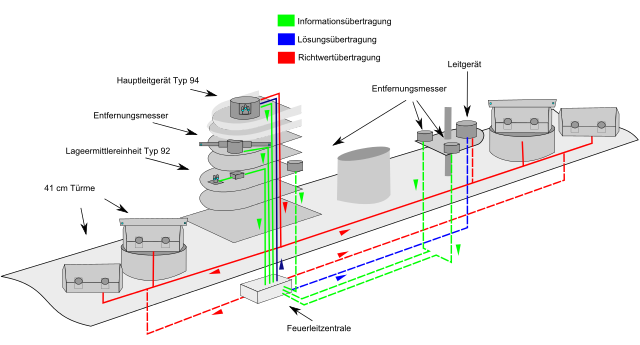
The main turrets faces were protected by 305 mm, but it was sloped, to to procure an artificial 330-350 mm in direct fire. Their sides were 230–190 mm (9.1–7.5 in) thick and the roof was 152–127 mm (6–5 in) thick. The main turrets barbettes were protected 305 mm (12-in) walls, and the secondary armament’s casemates were protected by 25 mm armor plates. The conning tower’s wall however were the thickest, at 369 mm (14.5 in) of the ship. hese figures are below the 16-in of their caliber, and can only be seen as a compromise, to deal with lighter caliber and save weight.
The main deck armor had an innovative three layers thickness, all in high-tensile steel (HTS) and 69 mm (2.7 in) thick. The lowest layer was connected to the of the upper strake of the belt, and its flat portion was layered with Ducol steel (25 mm thick), sandwiched between two layers of high-tensile steel.
This deck was situated 3 meters (9 ft 10 in) from the side of the hull, for a total of 75 mm (3 in) and sloped downwards, reduced to 66 mm (3 in)) as connecting to the main armored belt and torpedo bulkhead. The latter was also made of three 25 mm layers of HTS, curved up and outwards to meet the horizontal armored deck, enclosing a water-tight compartment 3.05 meters (10 ft 0 in) away from the side, backed by fuel oil tanks 3.13 meters (10 ft 3 in) deep. This arrangement was made to dissipate the torpedo warhead force and oil was supposed to stop fragments from penetrating the innermost bulkhead.
Nagato’s class Powerplant
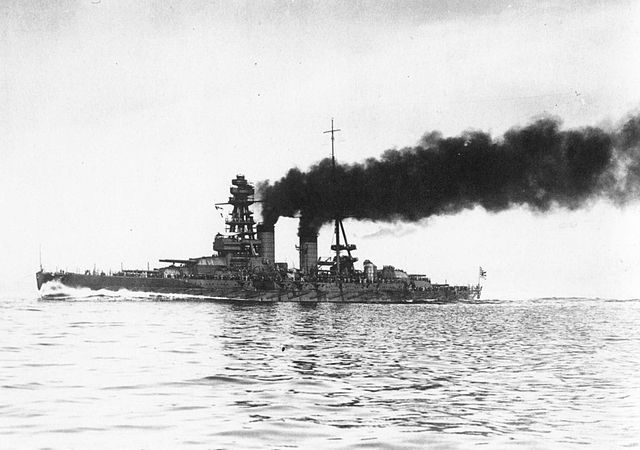
Nagato on sea trials, 30 september 1920
To carry all this weight, both ships received the same powerplant, with four Gihon geared steam turbines, driving each one 4.19-meter (13 ft 9 in) propeller. In total they were designed to deliver and output of 80,000 shaft horsepower (60,000 kW). Steam was provuded by 21 Kampon water-tube boilers, of which 15 of were oil-fired, the remainder coal, with sprinklers of fuel oil to increase the burn rate. Their working pressure was 286 psi (1,972 kPa; 20 kgf/cm2). This power allowed them to reach their design speed of 26.5 knots (49.1 km/h; 30.5 mph). For the time it was battlecruiser speed. During sea trials, IJN Nagato reached 26.7 knots (49.4 km/h; 30.7 mph) at 85,500 shp (63,800 kW) while Mutsu reached the same with 87,500 shp. The USN was only informed of these figures in 1937 and it was assumed they could only reach 23 knots (43 km/h; 26 mph)
Both ships carried 1,600 long tons (1,626 t) of coal, 3,400 long tons (3,455 t) of fuel oil. Estimated range was 5,500 nautical miles (10,200 km; 6,300 mi) at 16 knots (30 km/h; 18 mph) cruising speed.
Nagato’s class armament
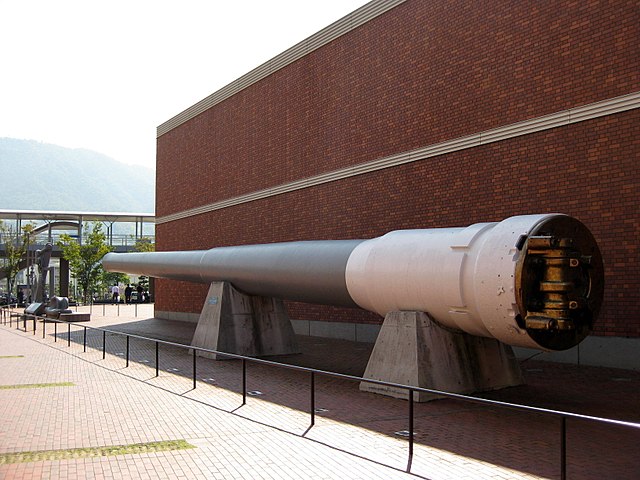
Main:
The great novelty of the design compared to the relatively simimalr Fuso & Ise classes, were a brand new main armament of eight 45-caliber 41 cm (16.1 in) 3rd Year Type naval guns (as first planned) mounted in two pairs of superfiring turrets fore and aft. They were hydraulically operated, and their elevation range was −2 to +35 degrees. Rate of fire was of two rounds per minute. They fired the Type 91 armor-piercing capped shell, 1,020 kgs at a muzzle velocity of 780 mps (2,600 ft/s). They also fired a HE shell, 936-kilogram (2,064 lb) with a muzzle velocity of 805 mps (2,640 ft/s) and the special Type 3 Sankaidan incendiary shrapnel exclusively for anti-aircraft use.
Secondary:
It was made of twenty 50-caliber 14 cm (5.5 in) 3rd Year Type naval guns mounted in casemates on two levels, on the hull’s upper level and in the superstructure. Their elevation ranged from +20 to +25 degrees and ranges of 15,800 meters – 17,000 meters (19,000 yd) respectively on these two levels. They were all provided with a unique 38 kgs (84 lb) HE shell and their rate of fire was to 10 rounds per minute.
Anti-aircraft guns: At the time air threat was still not taken seriously and it was limited to four 40-caliber 3rd Year Type 3-inch AA guns, all in single mounts. They elevated to +75 degrees, had a rate of fire of 13-20 rpm, and fired a 6 kg (13 lb) shell at 680 m/s (2,200 ft/s). Their effective ceiling was 7,500 meters (24,600 ft).
Torpedo Tubes: Each battleship was fitted with eight 53.3-centimeter (21 in) torpedo tubes: Four fired from the beam, in two groups, two above water and two submerged per side. They were supplied with the 6th Year Type torpedo, carrying a 203-kilogram (448 lb) warhead of Shimose powder. They had three settings: 15,500 m/26 knots, 10,000 m/32 knots, 7,000 meters/37 knots. This was still relatively slow and they were removed in the 1920s as seen an obsolete feature.
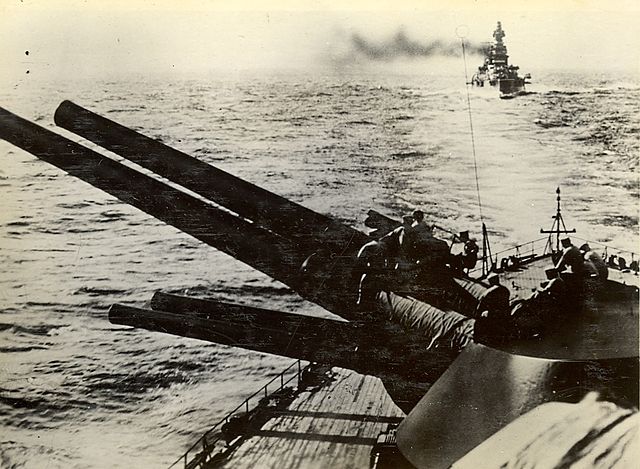
Mutsu’s main guns
Fire control:
The main rangefinder were 10-meter (32 ft 10 in) wide, installed in the forward superstructure for the main artillery and it was completed by a six-meter (19 ft 8 in) telemeter and a three-meter (9 ft 10 in), both for anti-aircraft purposes, added in 1924-25.
The main model was the Type 13 fire-control system, a derivative of the Vickers WWI system delivered for the previous Fuso and Ise, but in 1925 it was replaced by the much improved Type 14. The same unit controlled the main and secondary artillery. AA fire was only controlled from the Type 31 fire-control director installed in 1932.
Nagato and Mutsu’s reconstructions
1924-25:
The first refit happened in 1923–25, and concerned the powerplant: The fore funnel was rebuilt to prevent smoke interference but this was not successful and it was eliminated in the 1930s reconstruction. In 1926, the four above-water torpedo tubes were removed, and the AA was reinforced by three additional 76 mm AA guns placed around the base of the foremast.
Also for the first time, onboard aviation was installed: IJN Nagato already tried briefly a 18-meter aircraft flying-off platform on No. 2 turret in August 1925, launching Yokosuka Ro-go Ko-gata and an Heinkel HD 25 floatplane. In 1926 an additional boom was fitted to the mainmast, handling the Yokosuka E1Y. Alternatively the Hansa-Brandenburg W.33 was tested on IJN Nagato. These were just put at sea when the weather was calm and retrieved by the boom.
1932:
In 1932 there was another upgrade: The old 3-in AA guns were removed and replaced by eight 40-caliber 12.7-centimeter in four twin dual purpose Type 89 guns, installed abreast of the fore and aft superstructures. Range for sea targets was 14,700 meters (16,100 yd) and they fired at 14 rounds a minute, 8 rpm sustained. Two twin licenced Vickers 2-pdr light AA guns were also added, each capable of 200 rpm. Also that year, rangefinders in the two superfiring turrets were replaced by new 10-meter units in.
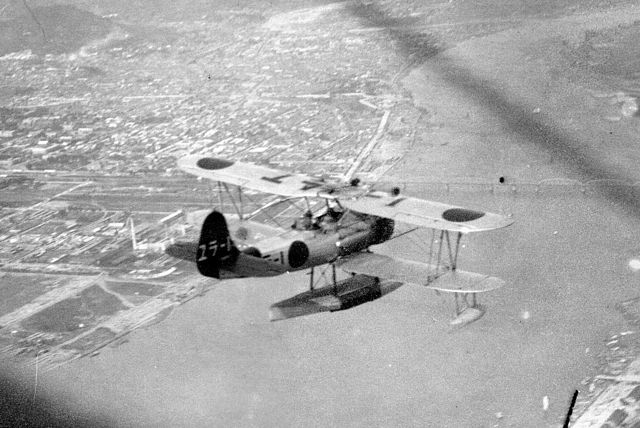
Nakajima E4N2
In 1933, a catapult was fitted between the mainmast and X turret and a collapsible crane installed on a portside sponson; Facilities were built to house and maintain 2-3 floatplanes, although ther was no true hangar. They operated first Nakajima E4N2 biplanes until 1938 and then Nakajima E8N2 biplanes. In November 1938 also a new catapult, much more powerful was installed. This enabled the launching of the much heavier and faster Kawanishi E7K in 1939–40. However by February 1943, the E8Ns were replaced by Mitsubishi F1M biplanes.
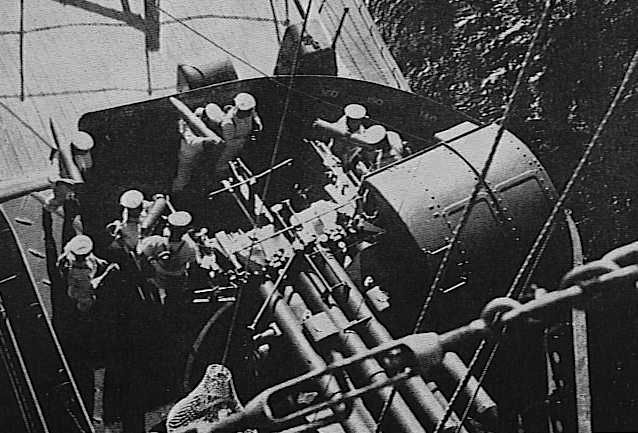
IJN Nagato’s 127 mm AADP battery
1934-36:
Nagato and Mutsu’s major overhaul took place in 1934-36. They will received new turbine engines and ten oil boilers instead of the original 21 mixed burning (cooal and oil) and a modified supertructure with large anti-torpedo bulges as originally planned by Hiraga, making a a triple hull, while the old Vickers AA guns were replaced by four twin 3-in turrets, and ten twin 25mm AA, at the cost of sacrificing two barbettes. Also, the remaining torpedo tubes were removed. Their boilers were replaced by modern Kampon models which working pressure was 313 psi (2,158 kPa; 22 kgf/cm2) at 300 °C (572 °F) and the turbines were also of a new, lighter and more powerful model, with 4.3-meter (14 ft 1 in) propellers. Post-reconstruction trials showed speed of 24.98 knots (46.26 km/h; 28.75 mph) with 82,300 shp. Additional fuel oil was stored in the torpedo bulges compartments, for 5,560 long tons total, extending their range to 8,560 nmi (15,850 km; 9,850 mi) at 16 knots.
All of the remaining secondary guns received a new mount, allowing their elevation to be increased to +35 degrees, and range to 20,000 m (22,000 yd). Around twelve or more Twin license-built 13.2-mm Hotchkiss HMGs (M1929, Type ??) were added too, but their range was limited to 6,500 meters (7,100 yd) and 700–1,500 m (770–1,640 yd) for effective AA fire, and 425 and 475 rpm, adjustable. They used 30-round magazines to their effective rate was down to 250 rounds per minute even with a well-trained crew.
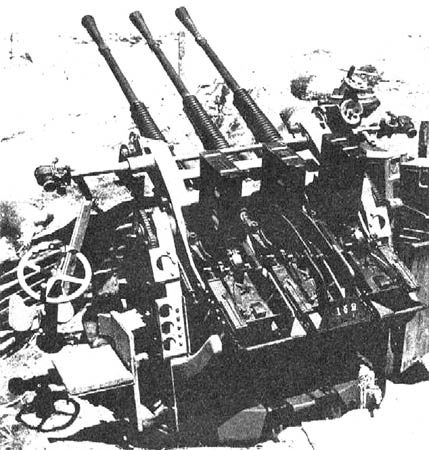
Type 96 Hotchkiss AA triple mount
According to historian Mark Stille, the twenty twin and triple Type 96 mounts added also “lacked sufficient speed in train or elevation; the gun sights were unable to handle fast targets; the gun exhibited excessive vibration; the magazine was too small, and, finally, the gun produced excessive muzzle blast”. They had an effective range of 1,500–3,000 meters (1,600–3,300 yd) and maximum rpm of 110-120, working with 15-round magazines. Additional 25 mm guns were added on IJN Nagato, and on 10 July 1944, 98 of these were listed, in single, twin and triple mounts, and later 30 more added during a refit in Yokosuka in November 1944 and two more twin 127 mm gun mounts abreast the funnel. By 1945, all the remaining secondary 140 mm guns had been removed. This saved weight, crew and space.

Nagato’s 127 mm AADP
The main guns also were also improved: New turrets from the discarded Tosa were installed during the 1935 reconstruction; They had a better armour, the face reaching 460 mm (18 in), and the side 280 mm (11 in), roof 230–250 mm (9–10 in). The machinery and magazines upper armour was increased by a layer of 38 mm (1.5 in) on the upper deck, 25 mm on the upper armored deck. The newly added torpedo bulges were 13.5 meters (44 ft 3 in) high, 2.84 meters (9 ft 4 in) deep and divided into four compartments: The lower two were filled with oil, the remainder were left free for all kinds of storage. Eventually, these all increased displacement to an extra 13,032 metric tons (12,826 long tons) for the ship’s armor, 32.6% of their displacement in total. In early 1941, the uppermost bulge compartment was filled with sealed steel crushing tubes. The barbette armor was reinforced by 100 mm armor plates welded above the main deck and an extra layer of 215 mm (8.5 in) plates below the barbette armor.
Also a modified Type 14 fire-control system was tested on IJN Nagato in 1935, approved for service and adopted as the Type 34, also fitted on IJN Mutsu. The Type 94 AA fire director replaced the former one, used to control the 127 mm DP AA guns, installed in 1937. The 25 mm AA guns were controlled by a Type 95 director installed the same year.
By May 1943 while in drydock, IJN Nagato received a Type 21 air-search radar, on the roof of the main 10 m rangefinder. On 27 June 1944, two extra Type 22 surface-search radars were installed and the same spot, at aft, two Type 13 early warning radars on the mainmast. None were installed on Mutsu before her loss.

Author’s HD profile illustration of the Nagato

IJN Ise camouflaged in Kure 1945 – colorized by Hirootoko Jr. It gives clues about the look of Nagato’s camouflage in July 1945.
Specifications
Displacement: 37,800 t. standard – 42,300 t. Full Load
Dimensions: 221 m long, 34.59 m wide, 9.50 m draft (full load)
Propulsion: 4 propellers, 4 Parsons turbines, 10 Kampon boilers, 80,000 hp, Maximum speed 27 knots
Shielding: Maximum (belt) 305 mm, turrets 508-356 mm, ammunition magazines 130 mm, citadel 350 mm.
Armament: 8 x 406 mm (4×2), 18 x 140 mm barbettes, 8 x 127 mm AA, 20 x 25 mm Type 96 AA (96 1944), 3 seaplanes Nakajima.

wow’s rendtion of the IJN Nagato, stern view
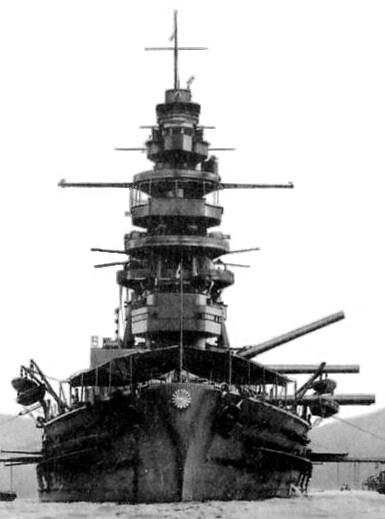
Read More/Src
Conway’s all the world’s fighting ships 1906-1921 & 1922-46
https://en.wikipedia.org/wiki/Japanese_battleship_Nagato
https://www.deviantart.com/tzoli/art/Japanese-Project-Numbers-788636685
https://warshipprojects.com/
http://www.maritimequest.com/warship_directory/japan/battleships/mitsu_page_1.htm
http://combinedfleet.com/ships/nagato
Campbell, John (1985). Naval Weapons of World War II.
Friedman, Norman (2011). Naval Weapons of World War One.
Hackett, Bob; Kingsepp, Sander & Ahlberg, Lars (2009). “IJN Mutsu: Tabular Record of Movement”.
Hyde, Harlow A. (1988). Scraps of Paper: The Disarmament Treaties Between the World Wars.
Jentschura, Hansgeorg; Jung, Dieter & Mickel, Peter (1977). Warships of the Imperial Japanese Navy, 1869–1945.
Parshall, Jonathan & Tully, Anthony (2007). Shattered Sword: The Untold Story of the Battle of Midway.
Rohwer, Jürgen (2005). Chronology of the War at Sea 1939–1945: The Naval History of World War Two
Silverstone, Paul H. (1984). Directory of the World’s Capital Ships.
Skwiot, Miroslaw (2007). Nagato Mutsu, Part I-II. Encyklopedia Okretów Wojennych
Stille, Mark (2008). Imperial Japanese Navy Battleships 1941–45. New Vanguard.
Whitley, M.J. (1998). Battleships of World War II.
Williams, Mike (2009). Jordan, John (ed.). Mutsu – An Exploration of the Circumstances Surrounding Her Loss. Warship 2009.
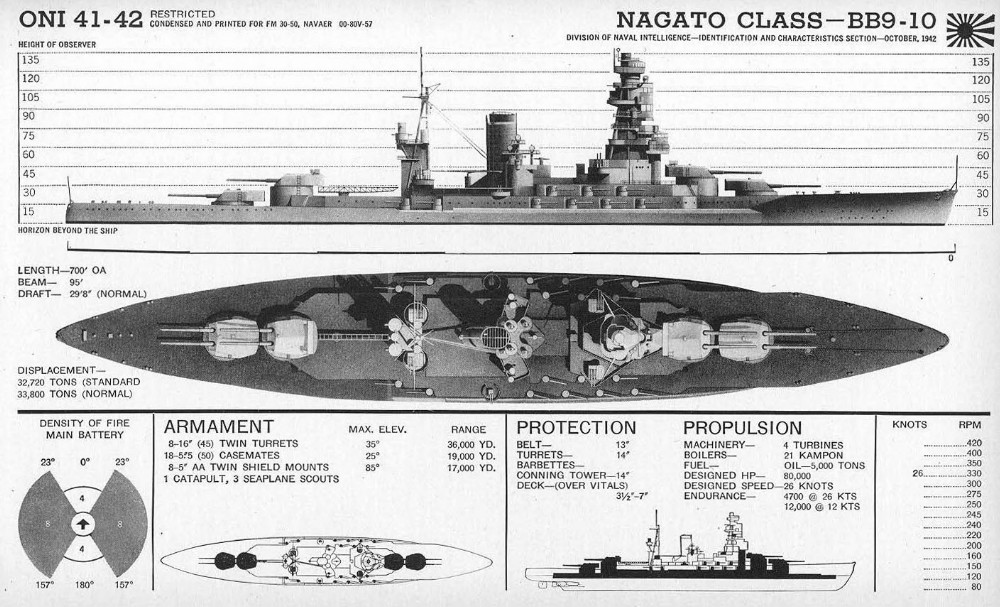
ONI recoignition plate
Nagato and Mutsu early career 1921-1934
IJN Mutsu was almost cancelled and broken up: While she was still fitting out, the Washington naval treaty settled on 12 November, the Americans proposing to scrap every capital ship under construction at that time, and IJN Mutsu was therefore concerned even though she was just commissioned. The Japanese delegation found it totally unacceptable and the Americans accepted a compromise, giving a derogation in exchange for scrapping the IJN Settsu while on their side, they saved the Colorado-class.
Nagato and Mustu joined (and formed) the 1st Battleship Division, the best unit of the IJN, Nagato as flagship of Rear Admiral Sōjirō Tochinai. In 1922, Nagato hosted Edward, Prince of Wales and Louis Mountbatten during his visit to Japan. The 1923 Great Kantō earthquake, provoked a reaction of the navy and both ships loaded supplies from Kyushu, delivered on 4 September. On 7 September 1924 they made a gunnery practice in Tokyo Bay, sinking the old Satsuma, also to reduced tonnage after the Washington Naval Treaty. IJN Nagato from December 1925 became flagship of the Combined Fleet, with Admiral Keisuke Okada. They were modernized in 1923-25. IJN Mutsu in 1927 had the great honor to carry athe imperial mark, housing Emperor Hirohito for him to see the fleet maneuvers. This was repeated in 1933.
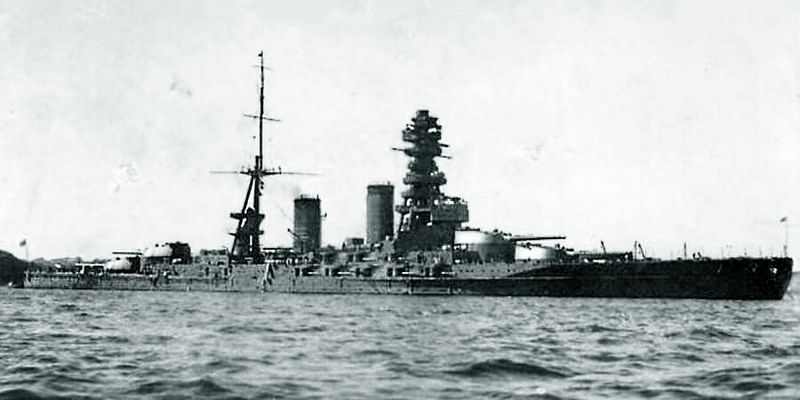
Mutsu in the 1920s
After their major reconstruction, in August 1937, both ships carried 3,749 infantry (11th Infantry Division) to Shanghai as war broke out with China. Their floatplanes not only spotted Chinese positions, they also strafed and bombed various targets in Shanghai on 24 August. Then, both ships departed for Sasebo. Nagato was used as a training ship on 1 December 1937 and flagship of the Combined Fleet a year and 15 days later in 1938. Both participated in the Imperial Fleet Review on 11 October 1940 and they were drydocked in 1941, in preparation for war. This included the fitting of external degaussing coils and additional barbette armor.
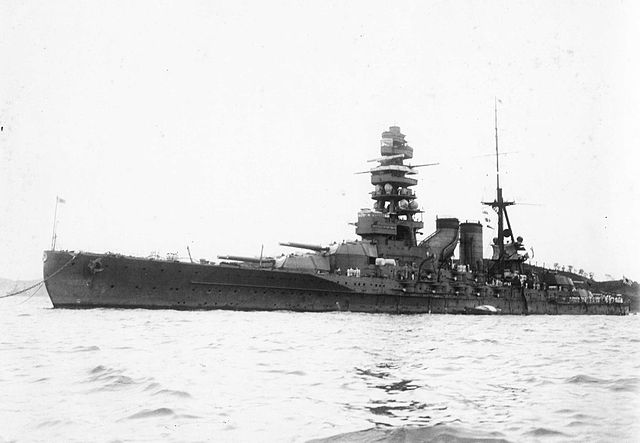
IJN Nagato in 1927
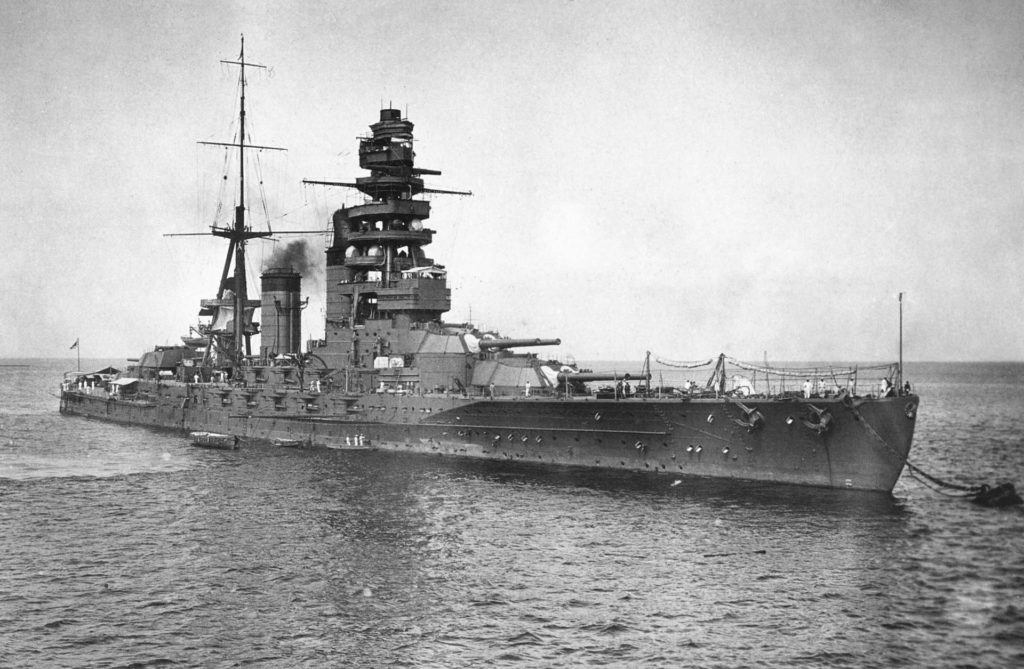
IJN Nagato at anchor in 1924 (HD photo)
IJN Nagato and Mutsu’s wartime career
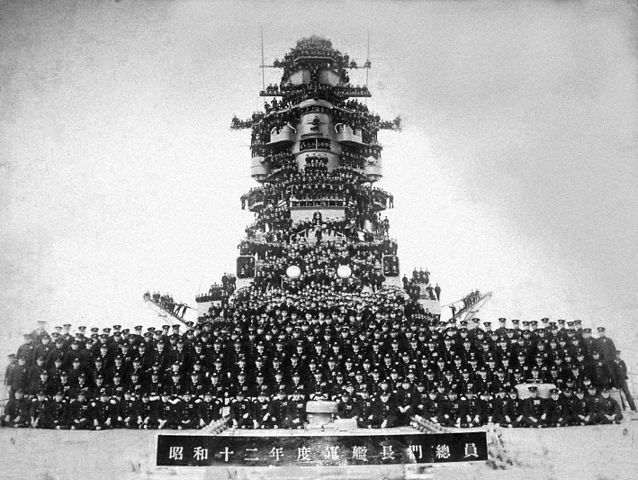
Nagato’s crew in 1937
Like the Yamato and Musashi, both battlecrisers were relatively preserved, being used on distant covers or cancelled operations, and rarely shot in anger. Nagato had a long career but her only classic gunnery was at Leyte when she targeted Taffy 3 escort carriers and destroyers and her results were poor, also due to local conditions. She also used AA shells in several occasions to repel air attacks wih some success, and was never severely damaged. In short, before she spend her remainder active life as a floating battery in Yokosuka, she never had been seriously tested and in 1946 survived two nuclear blasts. On the other hand Mutsu, apart some action at Guadalcanal, was soon blasted by a dramatic explosion which cut short her career.
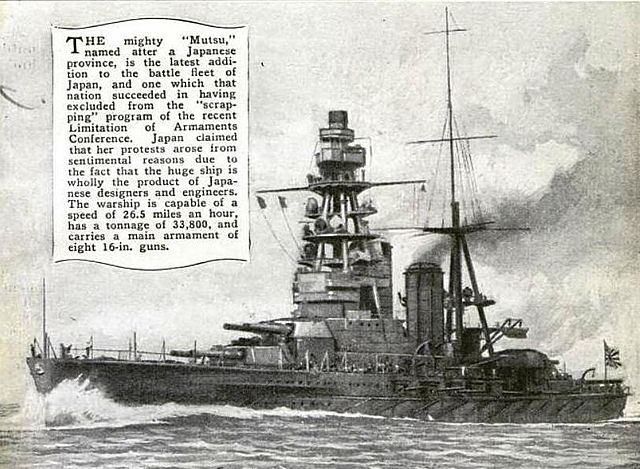
IJN Nagato as depicted in popular Mechanics 1922
IJN Nagato
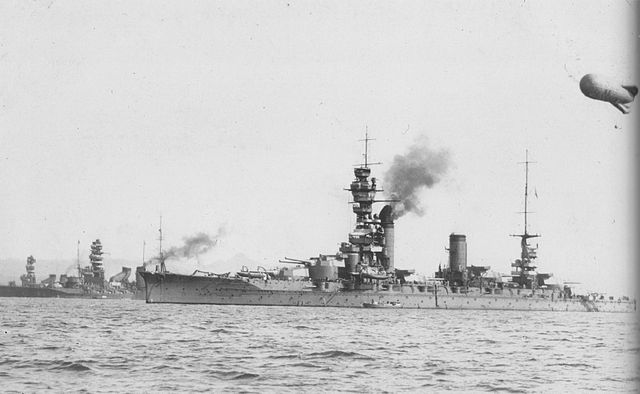
IJN Fuso, and Nagato on the background, in the 1920s.
Bonin Islands
The first wartime task of IJN Nagato was to protect the Kido Butai, under supervision of admiral Isoroku Yamamoto on 7 December 1941, as flagship. The famous code phrase “Niitaka yama nobore” was pronounced from Nagato’s brige on 2 December 1941 from IJN Nagato, then at anchor at Hashirajima. The 1st Air Fleet proceeded, and on 8 December, Nagato headed for the Bonin Islandswith her sister ship and IJN Hyūga, Yamashiro, Fusō, Ise (Battleship Division 1 and 2) and the light carrier Hōshō. They acted as distant cover for fleet coming from Pearl Harbor. Yamamoto would later transferred his flag on the IJN Yamato on 12 February 1942. Nagato had a small refit in Kure on 15 March – 9 April 1942 and in June, she was back in operations under command of captain Hideo Yano.
Midway
She was assigned to 1st Fleet deployed to act as distant cover for the attack on Midway. This fleet also comprised IJN Yamato, Mutsu, Hosho, the cruiser Sendai, nine destroyers and four auxiliary ships. The battle of Midway was played without this force intervene and four carriers were lost: Yamamoto tried to attempt to lure the US forces west, within range of IJN air groups at Wake and doubling with a night engagement with his mighty surface forces, but the carrier force withdrew. IJN Nagato would carry survivors of the aircraft carrier IJN Kaga back home. On 14 July, Nagato was now part of Battleship Division 2 but as flagship of the 1st Fleet. Her captain was promoted to Rear Admiral on 1 November 1942 so he was replaced by Captain Yonejiro Hisamune and Nagato remained in Japanese waters for exercises until August 1943. Captain Mikio Hayakawa replaced Hisamune that month.
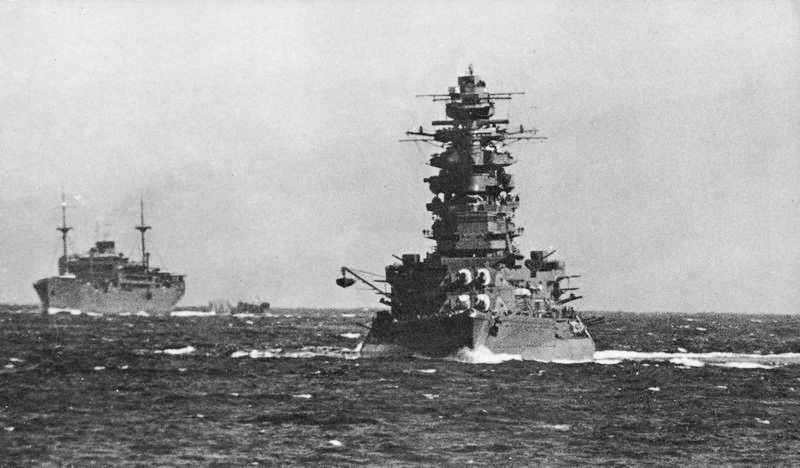
IJN Yasukuni Maru and Nagato in October 1941
Truk
Still in August, IJN Nagato departed to join IJN Yamato, Fusō and the carrier Taiyō, two heavy cruisers and five destroyers to Truk in the Caroline Islands. After the carrier raid on Tarawa (18 September) the fleet made a sweep to Eniwetok, looking for the American forces, but failed to do so and were back to Truk on 23 September 1943. American radio traffic was intercepted, suggesting an attack on Wake Island. On 17 October, the 1st Fleet headed again for Eniwetok and join a good interception position on 19 October. Eventually this was never realized and the fleet was back to Truk on 26 October. Captain Hayakawa became Rear Admiral on 1 November 1943 and was replaced on 25 December by Captain Yuji Kobe.

Akagi and Nagato
On 1 February 1944, Nagato and Fusō exited Truk to avoid one of the frequent American air raid, and was in Palau on 4 February, leaving on 16 February as another air raid was to take place. On 21 February both were in Lingga Island near Singapore. By that time, IJN Nagato became the flagship of Vice Admiral Matome Ugaki, Battleship Division 1 commander. On 5 May however he transferred his flag to Yamato and after a brief refit at Singapore, Nagato remained in Lingga, for training until 11 May, the joined Tawitawi on 12 May. The division teamed up with the 1st Mobile Fleet, (Vice Admiral Jisaburō Ozawa), ready for upcoming operations.
Mariana islands
On 10 June, Battleship Division 1 headed Batjan in preparation for Operation Kon, the planned attack of the invasion force over Biak. Howver the operation was cancelled by Admiral Soemu Toyoda, C-in-C of the Combined Fleet as a massive attack on Saipan took place. Ugaki’s force then headed for the Mariana Islands, meeting Ozawa’s force on 16 June. IJN Nagato then participated in the Battle of the Philippine Sea. She escorted the aircraft carriers Jun’yō, Hiyō and the light carrier Ryūhō during the battle and fired its Type 3 Sankaidan incendiary anti-aircraft shrapnel shells at the USN aviation. These 410 mm “giant shotgun” shells proved their relative lethality against USS Belleau Wood air groups, claiming two Grumman TBF Avenger torpedo bombers. Although strafed, Nagato had only light damage and no casualty. She could not protect Hiyō however and picked up her suvivors, later transferred on Zuikaku at Okinawa on 22 June 1944. She was back to Kure for a refit, including additional radars and many more 25 mm AA guns. On 8 July she embarked a regiment of the 28th Infantry Division and landed them on Okinawa on 11 July and was later back at Lingga on 20 July 1944.

Battle of Leyte Gulf
On 18 October IJN Nagato sailed for Brunei Bay in Borneo, joining the fleet in preparation for “Operation Sho-1“, the attack on the American landings at Leyte. The plan was complex, comprising Ozawa’s dummy carrier forces as a bait to draw out Hasley’s American carrier fleets north of Leyte, allowing Vice Admiral Takeo Kurita’s 1st Diversion Force to sneak out in Leyte Gulf and fell over the American forces. Nagato departed on 22 October and at the Battle of the Sibuyan Sea two days later she fended off many waves of USN dive bombers. However at 14:16 she was hit by two bombs from USS Franklin and Cabot. The first disabled several casemate guns and damaged the air intake for No. 1 boiler room. This caused one shaft t to be short down for urgent repairs, done in 24 minutes. After the attack, Nagato had 52 KiA and many more wounded.
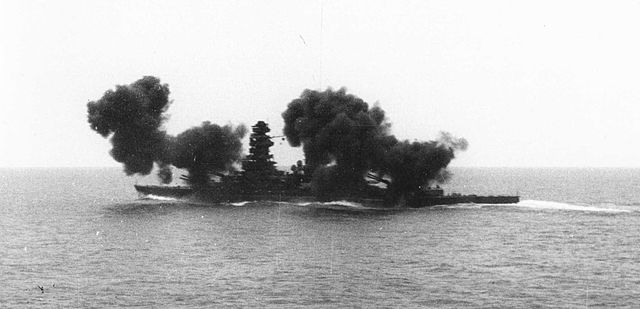
IJN Nagato firing
On 25 October at dawn, the 1st Diversion Force at last passed the San Bernardino Strait and deployed in the bay for what became the Battle off Samar. IJN Nagato at 06:01 commenced shelling the escort carriers of “Taffy 3” (the famous Task Group 77.4.3). This was the first time in this war she actually fired on another warship, but missed the carriers. 54 minutes after, however destroyer USS Heermann closed enough to launched its torpedoes on IJN Haruna; nearly missing but still running towards Yamato and Nagato. They headed 10 miles (16 km) away to avoid them and went back to the brawl. IJN Nagato resumed firing and this time claimed to have damaged a cruiser, expending 45 main shells and 92 secondary one. The fire was ineffective due poor visibility in rain squalls and smoke screens, ably laid by the destroyers.
At 09:10 Kurita had enough and ordered a general withdrawal, heading north and one hour later south again, but met a massive air attack and ordered a general retreat at 12:36. An opportunity was missed for the Japanese. During one of these attacks, at 12:43 Nagato received two bombs hits to the bow, but damage was light, and she made sharp turns to avoid further attacks, loosing four men in the process. She was back to Brunei on 26 October 1944, enduring more air attacks. Both Nagato and Yamato again used their special AA Sankaidan shells, claiming many more planes, and in two days fired 99 main and 653 secondary shells, with 38 KiA and and 105 wounded.
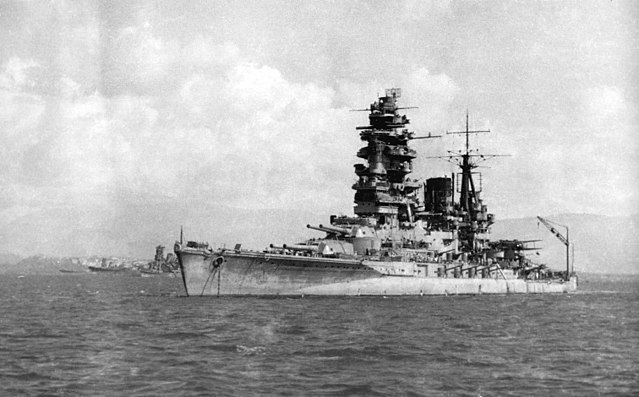
IJN Nagato in brunei, 1944
The end: Floating battery at Yokosuka
By 15 November, IJN Nagato was assigned to Battleship Division 3, 2nd Fleet. She left Brunei on 16 November with Yamato and Kongō for Kure, loosing en route the latter and an escorting destroyer to the submarine USS Sealion. On 25 November, Nagato was in Yokosuka for a refit, but this dragged on due to the Lack of fuel and materials. At the end, it was decide to use Nagato as a floating anti-aircraft battery. Completely immobilized, she saw her funnel and mainmast taken down to improved the arcs of fire of her light guns, two more twin Type 89 and nine triple Type 96 mounts (31 in all) while her forward secondary guns were retired. Captain Kiyomi Shibuya took command in November and eventually Battleship Division 3 was disbanded January 1945, the force remaining being part now of Battleship Division 1, disbanded in turn in February.
IJN Nagato became until the end of the war a static defense ship, attached to the Yokosuka Naval District; She was moored permanently to a pier, with an auxiliary coal-burning boiler for heating and cooking and converted submarine chaser provide steam and electricity. Her anti-aircraft guns was impressive on paper, but the 25 mm were lacking range and hitting power while the crew lacked training as ammunitions were scarce. On 20 April IJN Nagato was placed in the reserve and Rear Admiral Miki Otsuka (ret.) took command. As a reserve ship which was stripped of part of hter supplies and equipments and most of the crew. Only remained those in charge of the AA batteries.
In June 1945, she was stripped of her secondary guns and half of her AA armament, moved ashore. Her rangefinders and searchlights were also lifted out carried away. Her crew was by then reduced to around 1,000 officers and sailors and by 18 July 1945 she had been heavily camouflaged, like Ise. Nevertheless she was attacked by air forces from five American carriers (Admiral William Halsey) hunting down the last IJN capital ships. Nagato was hit by two bombs, destroying the bridge, killing rear admiral Otsuka his executive officer and twelve sailors and another blew the deck killing 21 more. Her damage were left unrepaired and ballast pumped full to make her sit deeper and making US intelligence believed she had been badly hit in the vain hope to spare her.
Captain Shuichi Sugino took command on 24 July, but arrived on 20 August and Rear Admiral Ikeguchi (ret.) assigned in the meantime. On the night 1/2 August a large convoy was spotted closing to Sagami Bay. Nagato was prepared to attack, the ballast water was pumped out, the crew loaded shells for her 16-inch guns and she received fuel. However eventually no order came, as it was proved to be a false alarm. The battleship was eventually captured just before the end of the war on 30 august, by a crew of battleship USS Iowa and Underwater Demolition Team 18.
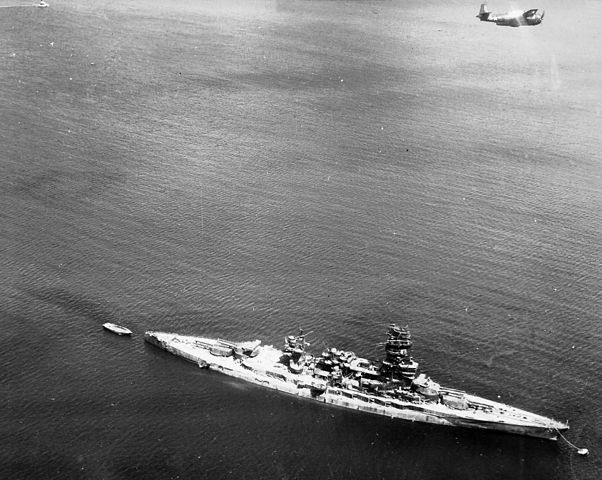
Nagato in Yokosuka, aerial view by the USN in July 1945
She stayed in the harbor under USN control until selected to take part as a target ship to Operation Crossroads, the nuclear test on Bikini atoll which took place in the summer of 1946. She made a perilous voyage from Yokosuka to Eniwetok under command of Captain W. J. Whipple, the remaining Japanese crew supplemented by an American crew, at 10 knots. Not only she leaked profuciously but her hull’s bottom was covered with bernacles. Later she tried to take in two IJN Sakawa, which powerplant broke down, but she later had a boiler malfunction and lost the remaining of her fuel in heavy weather. She had to be towed to Eniwetok was repaired, and reached Bikini at 13 knots. The test took place while Nagato was just 1,500 meters (1,640 yd) from ground zero and only took light damage (but massive radiation). A boarding skeleton crew assessed this and was able to start her boiler. During Test Baker, which was underwater she was positioned 870 meters (950 yd) from ground zero and hit without much damage by a tsunami wave, which amplitude was low so close to the epicenter. She started listed and was not boarded as she was now thought to be dangerously radioactive. She eventually capsized and sank during the night of 29/30 July 1946, remaining there until today. As radiation levels dropped she became a popular scuba diving destination…
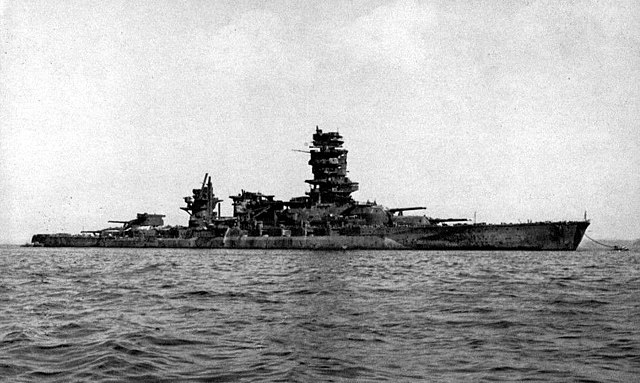
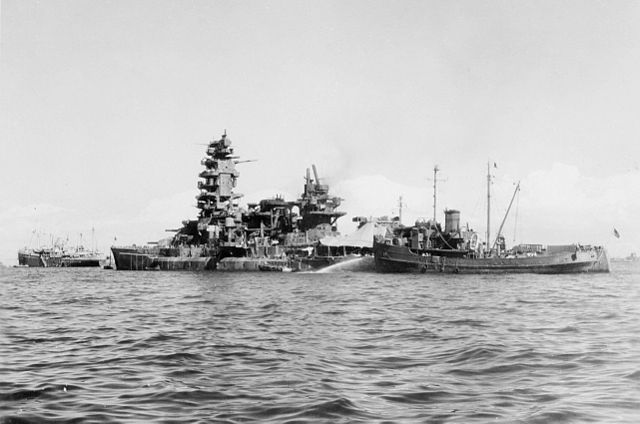
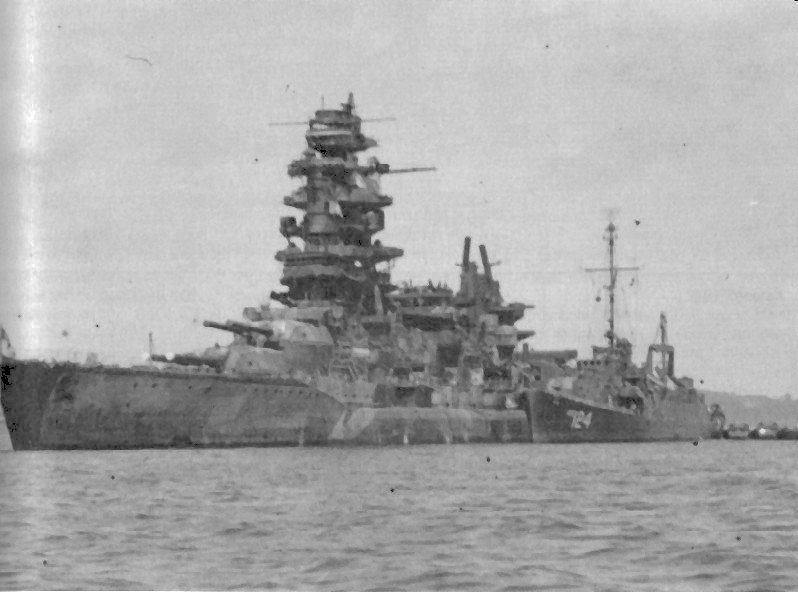
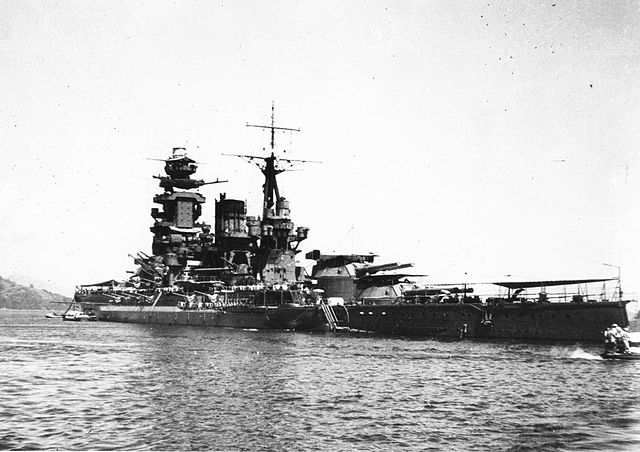
Various views of IJN Nagato at Yokosuka NyD in September 1945. She had been camouflaged at that point.
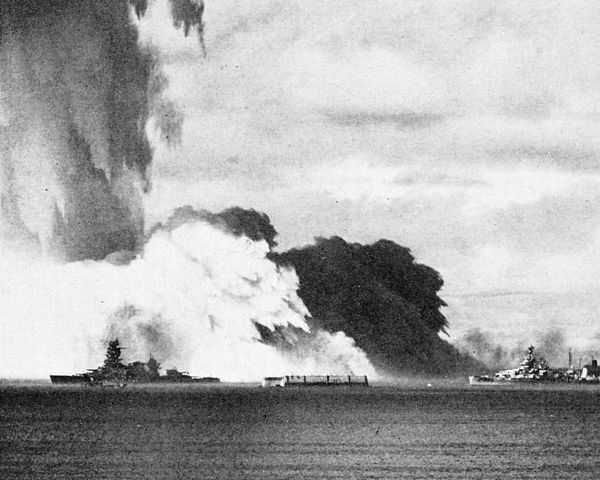
Operation crossroads, Baker test, 1946
IJN Mutsu
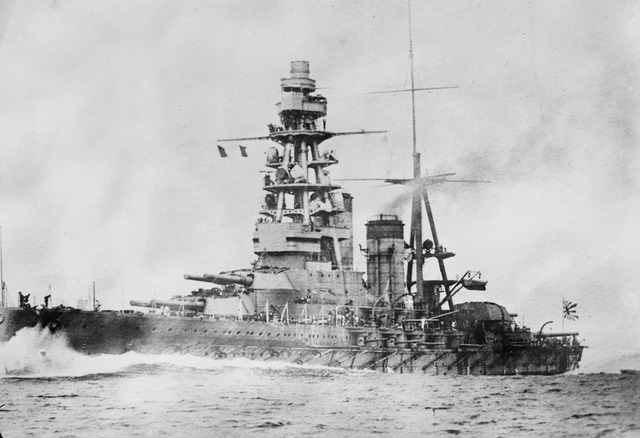
IJN Mutsu underway in 1922
Before the war, after reconstruction, IJN Mutsu landed 2,000 men of the 11th Infantry Division in Shanghai while her seaplanes strafed and bombed various targets on 24 August. On 15 November 1938, Captain Aritomo Gotō took command but she was in reserve for nearly one year, from 15 December 1938 to 15 November 1939 and refitted in early 1941, fitted with external degaussing coils and additional barbettes armour.
On 8 December 1941, she teamed with her sister ship and headed for the Bonin Islands to act as distant support for the operation on Pearl Harbor and on 18 January 1942, she towed the obsolete old Nisshin to serve as a target ship for IJN Yamato, freshly commissioned. In June 1942 (Rear Admiral Gunji Kogure) was assigned to the 1st Fleet committed during the Battle of Midway, and could have took part in Yamamoto’s planned night engagement, but the US forces withdrew.
Guadalcanal
On 14 July 1942, IJN Mutsu joined Battleship Division 2, acting as an advance of the 2nd Fleet in August and she teamed up with IJN cruisers Atago, Takao, Maya, Haguro, Yura, Myōkō, and seaplane tender Chitose for the Guadalcanal Campaign. She dropped anchors in Truk on 17 August. She later met Vice Admiral Chūichi Nagumo’s 3rd Fleet and tried to locate the escort carrier USS Long Island.
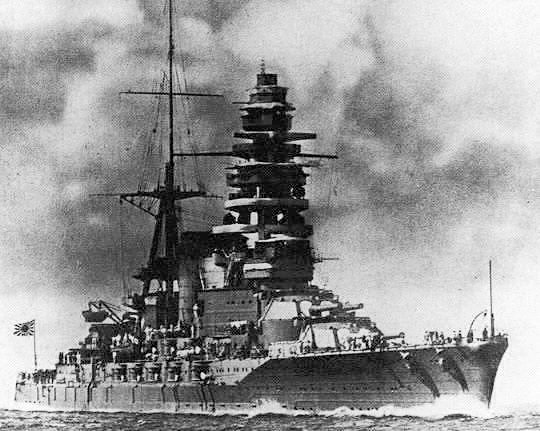
She was present at the Battle of the Eastern Solomons on 27 August: Assigned to the support force, she fired at enemy reconnaissance aircraft, the only time in this war she would fire her guns in anger. Back to Truk on 2 September her AA officers were landed to act as instructors for ground-based naval AA gunners in Rabaul. Inn October 1942, she off-loaded surplus fuel oil to the fleet oil tanker Kenyo Maru and on 7 January 1943, she sailed to Saipan and then back home, escorting the carrier Zuikaku, and heavy cruiser Suzuya. She left Hashirajima for Kure on 13 April 1943, prepared for a sortie to in the Aleutian Islands after the Battle of the Komandorski Islands. However the operation was cancelled.
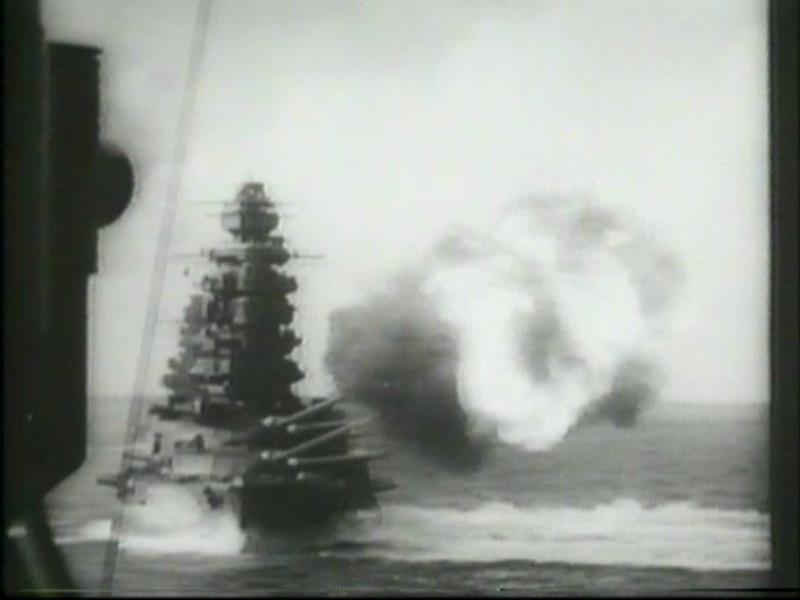
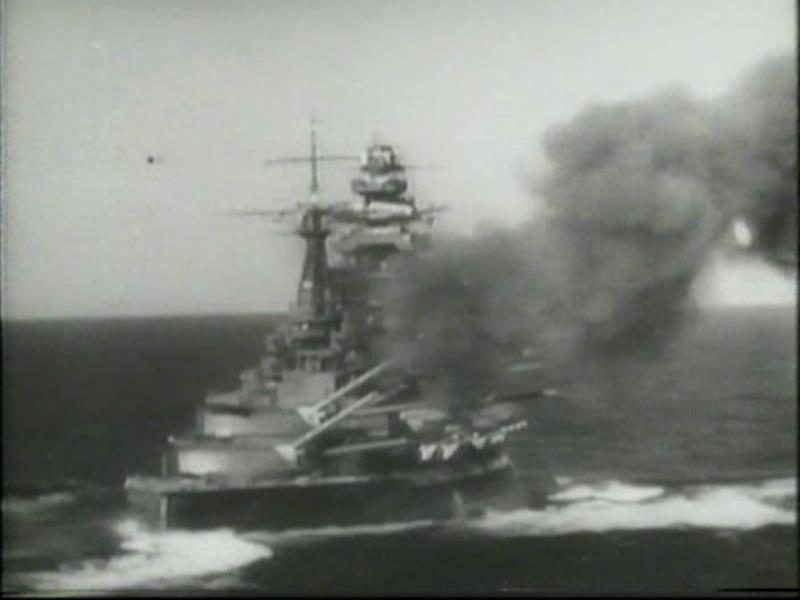
Footage extract – Hawai_Mare_oki_kaisen, IJN Mutsu firing in exercises.
Tragic loss
On 8 June 1943, while IJN Mutsu was moored in Hashirajima, she carried 113 flying cadets and 40 instructors from the Tsuchiura Naval Air Group, in order to familiarie with the ships. Suddenly at 12:13 the No. 3 turret magazine exploded. The blast destroyed all the adjacent structure of the ship, effectively cutting her in half. Water gushed into the machinery rooms, and the whole forward section of the ship, some 150 m (490 ft) long, capsized to starboard and sank, carrying with her trapped survivors. while the 45 m (148 ft) aft section remained afloat until 02:00 hours, 9 June, sinking in turn. Nearby Fusō launched two boats to try to rescue suvivors, as did destroyers Tamanami and Wakatsuki, cruisers Tatsuta and Mogami. Together, they managed to rescue 353 survivors. But 1,121 men were killed in the explosion and sinking, and 13 cadets aviators survived.
It was believed at first Allied submarines were in the area, but after a wide hunt, none was spotted or detected. To avoid Japanese morale to be hit, Mutsu’s loss was declared a state secret and sailors swore to keep it under death penatly. The surviving members of the crew were quickly reassigned to various garrisons in the Pacific Ocean, like Truk in the Caroline Islands or Saipan in the Mariana Islands. Mass cremations followed and Captain Teruhiko Miyoshi’s body was recovered on 17 June, his wife only notified on 6 January 1944. With Captain Koro Oono, both were posthumously promoted to rear admiral.
After it was established this was not due to an allied attack, an enquiry commenced. Soon the 16-inch Type 3 “Sanshikidan” incendiary shrapnel AA shells came dunder suspicion as they already caused a massive fire at the Sagami arsenal several years earlier. The problem identified was improper storage. The minister of the navy Admiral Shimada Shigetaro, ordered the removal of Type 3 shells from all IJN ships, waiting for the conclusions of the enquiry.
A commission was led by Admiral Kōichi Shiozawa and gradually estimated but ruled out vrious causes: Sabotage by enemy secret agents, by a disgruntled crewman, possibly of No. 3 turret. Indeed one had recently been accused of theft and was believed to be suicidal. Aslo ruled out athe action of an allied midget or fleet submarine attack. They were ledt with a accidental explosion probably caused by mishandling of the Type 3 anti-aircraft shell. The “sanshiki-dan” was Japanese AA “secret weapon”, 900 to 1,200 25 mm diameter steel tubes containing an incendiary charge each. Tests at Kamegakubi Naval Proving Ground were unable to induce the shells to explode under normal conditions. The commission concluded on 25 June, before divers completed their investigation, leaning to the hypothesis of a disgruntled seaman and closed the case.
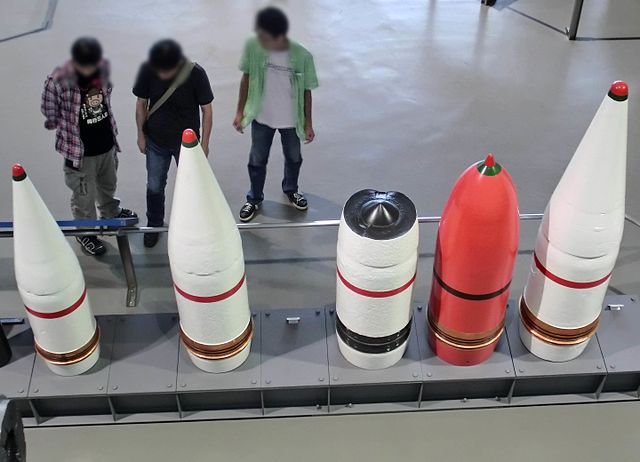
IJN Battleships, including Nagato 410 mm shells in a museum
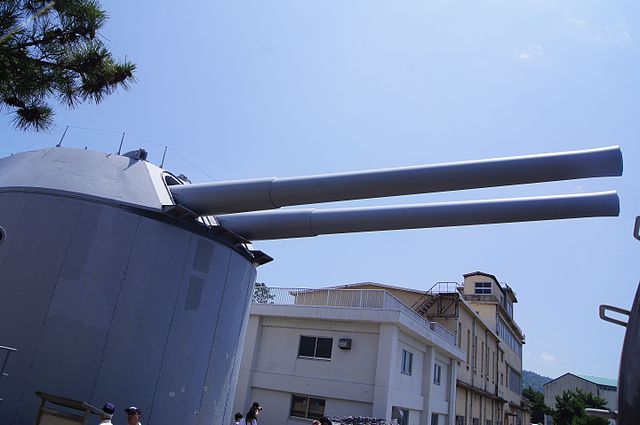
IJN Mutsu aft deck main turret, Imperial Japanese Naval Academy, Eta Jima.
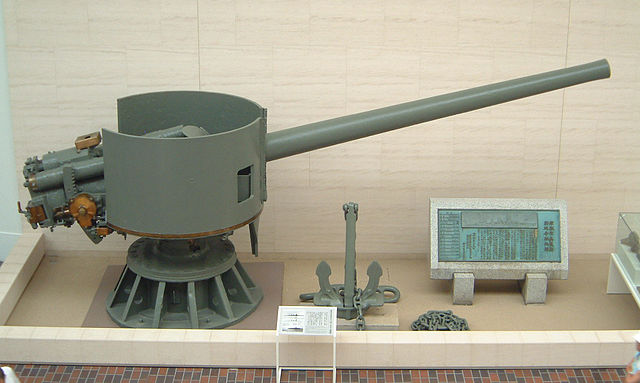
Type 3 410 mm gun from IJN Mutsu in a museum
Post war, some authors also investigated. Observers of the time notably noted smoke coming from the vicinity of No. 3 turret just before the explosion. IJN warhips were known for loose afetry measures and carry loads of flammable materials like wooden decking, furniture, and insulation, cotton and wool bedding. The original electrical wiring also was kept in part, causing potential shortcuts sparks, and a fire could have heated up the sensitive black-powder primers stored in the magazine. After it was envisioned briefly to raise and rebuilt Mutsu, she was struck from the Navy List on 1 September 1943.
Her armament was salvaged, rused and partly restored and preserved after the war: A main turret at the Imperial Japanese Naval Academy, Eta Jima, and a secondary casemate gun at the Yasukuni Museum.

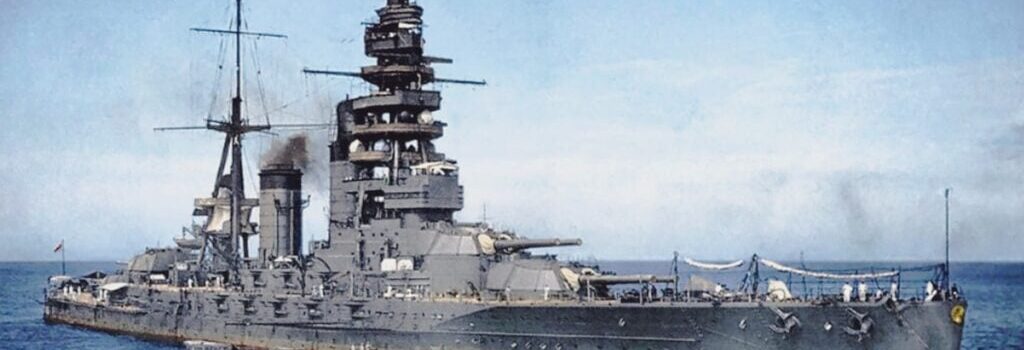

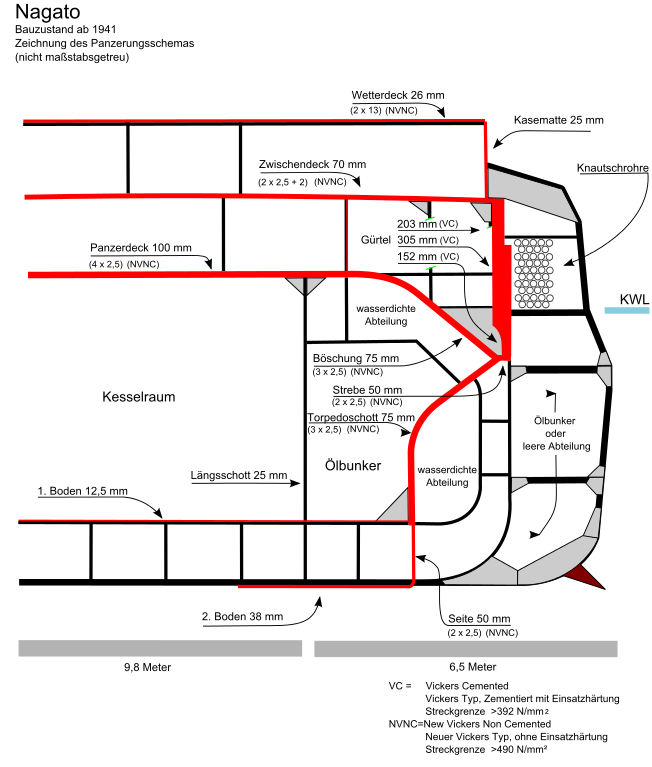
 Latest Facebook Entry -
Latest Facebook Entry -  X(Tweeter) Naval Encyclopedia's deck archive
X(Tweeter) Naval Encyclopedia's deck archive Instagram (@navalencyc)
Instagram (@navalencyc)





 French Navy
French Navy Royal Navy
Royal Navy Russian Navy
Russian Navy Armada Espanola
Armada Espanola Austrian Navy
Austrian Navy K.u.K. Kriegsmarine
K.u.K. Kriegsmarine Dansk Marine
Dansk Marine Nautiko Hellenon
Nautiko Hellenon Koninklije Marine 1870
Koninklije Marine 1870 Marinha do Brasil
Marinha do Brasil Osmanlı Donanması
Osmanlı Donanması Marina Do Peru
Marina Do Peru Marinha do Portugal
Marinha do Portugal Regia Marina 1870
Regia Marina 1870 Nihhon Kaigun 1870
Nihhon Kaigun 1870 Preußische Marine 1870
Preußische Marine 1870 Russkiy Flot 1870
Russkiy Flot 1870 Svenska marinen
Svenska marinen Søværnet
Søværnet Union Navy
Union Navy Confederate Navy
Confederate Navy Armada de Argentina
Armada de Argentina Imperial Chinese Navy
Imperial Chinese Navy Marinha do Portugal
Marinha do Portugal Mexico
Mexico Kaiserliche Marine
Kaiserliche Marine 1898 US Navy
1898 US Navy Sovietskiy Flot
Sovietskiy Flot Royal Canadian Navy
Royal Canadian Navy Royal Australian Navy
Royal Australian Navy RNZN Fleet
RNZN Fleet Chinese Navy 1937
Chinese Navy 1937 Kriegsmarine
Kriegsmarine Chilean Navy
Chilean Navy Danish Navy
Danish Navy Finnish Navy
Finnish Navy Hellenic Navy
Hellenic Navy Polish Navy
Polish Navy Romanian Navy
Romanian Navy Turkish Navy
Turkish Navy Royal Yugoslav Navy
Royal Yugoslav Navy Royal Thai Navy
Royal Thai Navy Minor Navies
Minor Navies Albania
Albania Austria
Austria Belgium
Belgium Columbia
Columbia Costa Rica
Costa Rica Cuba
Cuba Czechoslovakia
Czechoslovakia Dominican Republic
Dominican Republic Haiti
Haiti Hungary
Hungary Honduras
Honduras Estonia
Estonia Iceland
Iceland Eire
Eire Equador
Equador Iran
Iran Iraq
Iraq Latvia
Latvia Liberia
Liberia Lithuania
Lithuania Mandchukuo
Mandchukuo Morocco
Morocco Nicaragua
Nicaragua Persia
Persia San Salvador
San Salvador Sarawak
Sarawak Uruguay
Uruguay Venezuela
Venezuela Zanzibar
Zanzibar Warsaw Pact Navies
Warsaw Pact Navies Bulgaria
Bulgaria Hungary
Hungary

 Bundesmarine
Bundesmarine Dutch Navy
Dutch Navy Hellenic Navy
Hellenic Navy Marina Militare
Marina Militare Yugoslav Navy
Yugoslav Navy Chinese Navy
Chinese Navy Indian Navy
Indian Navy Indonesian Navy
Indonesian Navy JMSDF
JMSDF North Korean Navy
North Korean Navy Pakistani Navy
Pakistani Navy Philippines Navy
Philippines Navy ROKN
ROKN Rep. of Singapore Navy
Rep. of Singapore Navy Taiwanese Navy
Taiwanese Navy IDF Navy
IDF Navy Saudi Navy
Saudi Navy Royal New Zealand Navy
Royal New Zealand Navy Egyptian Navy
Egyptian Navy South African Navy
South African Navy






























 Ukrainian Navy
Ukrainian Navy dbodesign
dbodesign